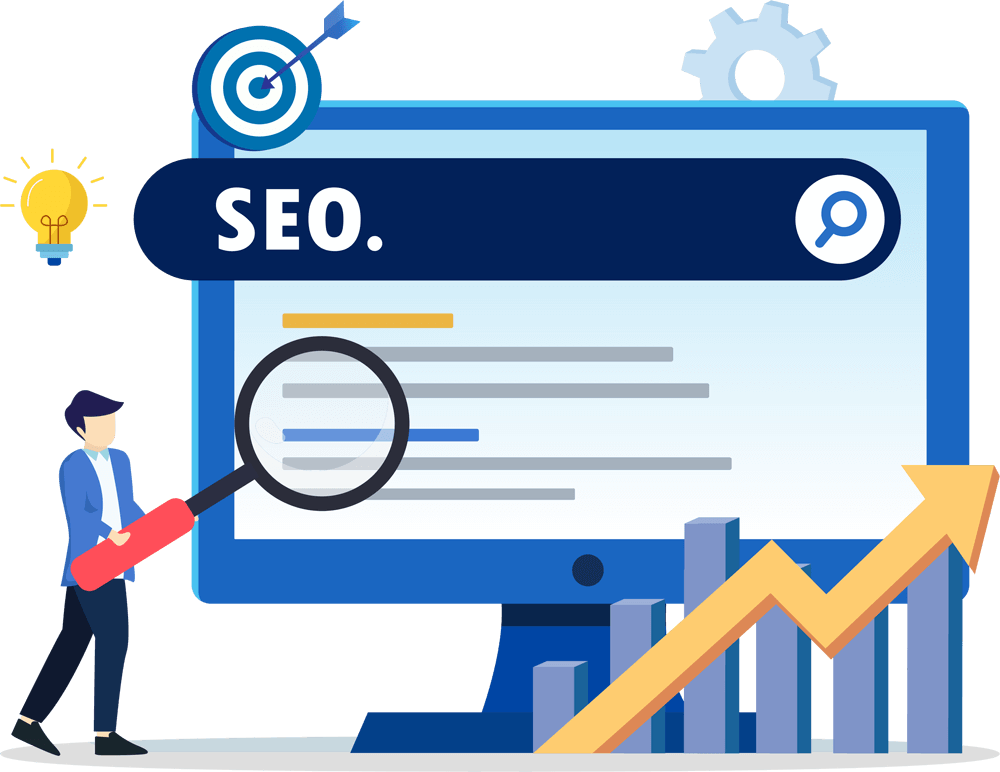Analysis and SEO Optimization – or how to be first in Google search
SEO analysis represents a website check, i.e., of all factors relevant to search engine ranking.
SEO optimization applies to already optimized sites that did not bring the expected results.


Simplified – if the website needs to be positioned better in the search, even with SEO optimization measures implemented, it is time for an SEO analysis. In the process of SEO analysis, on-page and off-page elements are subject to review and the detection of technical errors. The obtained results determine to what extent the SEO strategy is performing well and thus recommends specific SEO optimization measures to improve the ranking in the SERP.
It is almost impossible to make the right decision to improve a website’s ranking with a thorough SEO analysis. It reveals weaknesses in the SEO concept and gives guidelines on what needs to be changed or enhanced for the website to position high in the search – the best, organic one.
A perfectly optimized site implies multiple aligned elements so it can be crawled and indexed by Google. SEO analysis uses various SEO tools to check these website components and determine if any negative factors hinder rankings. Ideally, On-page analysis, Off-page analysis, and technical SEO analysis accomplish the process.
Simplified – if the website needs to be positioned better in the search, even with SEO optimization measures implemented, it is time for an SEO analysis. In the process of SEO analysis, on-page and off-page elements are subject to review and the detection of technical errors. The obtained results determine to what extent the SEO strategy is performing well and thus recommends specific SEO optimization measures to improve the ranking in the SERP.
It is almost impossible to make the right decision to improve a website’s ranking with a thorough SEO analysis. It reveals weaknesses in the SEO concept and gives guidelines on what needs to be changed or enhanced for the website to position high in the search – the best, organic one.
A perfectly optimized site implies multiple aligned elements so it can be crawled and indexed by Google. SEO analysis uses various SEO tools to check these website components and determine if any negative factors hinder rankings. Ideally, On-page analysis, Off-page analysis, and technical SEO analysis accomplish the process.

In the On-page SEO analysis, all on-page factors on the website are checked, among others: title, description and keywords, URL, internal links, duplicate content, page titles, and meta description.
This examination includes checking the XML-Sitemap. The next step is to check usability and User-experience (UX). In short, On-page SEO analysis evaluates the site’s internal structure.
Offpage SEO analysis is the research of external links leading to a website. It answers the following:
- What is the number of backlinks?
- What is the number of domains they come from?
- How are these domains indexed?
- What is the authority of the domains linking to the website?


Technical SEO analysis includes checking the technical settings on the site: site loading time, whether there is a robots.txt file on the site, whether the pages have a canonical tag, whether the site and its pages are indexed or whether access to certain pages is restricted.
The main problem with many SEO analyses happens when done automatically. In other words, SEO tools automatically perform on the website, and the result is a lengthy report that, unless they are an SEO expert, is pretty challenging to understand. There are plenty of SEO analysis tools on the market, many of which are free.
Some of the more famous ones are Google Analytics, Google Search Console, Google PageSpeed Insights, SEMrush, Ahrefs, Screaming Frog, Searchmetrics, Sistrix, and Seobility. Each of them serves to analyze different aspects of the website. Google Analytics shows, among other things, what users do on the website, how long they stay there, and which pages get viewed the most.
Technical SEO analysis includes checking the technical settings on the site: site loading time, whether there is a robots.txt file on the site, whether the pages have a canonical tag, whether the site and its pages are indexed or whether access to certain pages is restricted.
The main problem with many SEO analyses happens when done automatically. In other words, SEO tools automatically perform on the website, and the result is a lengthy report that, unless they are an SEO expert, is pretty challenging to understand. There are plenty of SEO analysis tools on the market, many of which are free.
Some of the more famous ones are Google Analytics, Google Search Console, Google PageSpeed Insights, SEMrush, Ahrefs, Screaming Frog, Searchmetrics, Sistrix, and Seobility. Each of them serves to analyze different aspects of the website. Google Analytics shows, among other things, what users do on the website, how long they stay there, and which pages get viewed the most.

Google Search Console and Screaming Frog are appropriate for technical SEO analysis. They can be used, for example, to check whether a website meets Google’s technical requirements and whether individual pages are indexed correctly.
For keyword analysis, competition and backlink analysis are used, for example, SEMrush, Sistrix, and Ahrefs. Google PageSpeed Insights provides data on how fast a website loads. However, free automatic SEO analysis often does not achieve the desired goal, which is always the rank increase, leads volume, and, consequently, sales.
The essence of SEO analysis is interpreting the obtained data and finding specific measures to improve SEO optimization performance. In this sense, a good SEO expert is indispensable because SEO analysis brings effective results only if the right SEO tools combine with the knowledge and experience of SEO experts.

Local SEO – how to position yourself locally in a global network

Local SEO is a specific form of SEO optimization and represents one of the most important marketing strategies that provide an edge over local competition. It is becoming increasingly important in recent years, as it allows a website to be optimized to rank better for a local audience – which is what all non-global businesses strive for. If the objective is to attract customers near your business, targeting the entire online population is pointless.
The goal of a local business owner is to reach potential clients from their area, and the purpose of someone using Google search is to find a specific product or service in their city or nearby location. So both local business owners and search engine users have a common interest.
Local SEO enables the completion of this common interest – the way Google presents search results based on geographic location, which is the perfect marketing tool for attracting local customers. When someone searches, e.g., “dentist,” Google will show the user a map with the nearest offices, reviews, and phone numbers. Pursuing its ultimate goal of connecting the user to the intent of their search as efficiently as possible, Google introduced local search in 2007.
Local SEO is a specific form of SEO optimization and represents one of the most important marketing strategies that provide an edge over local competition. It is becoming increasingly important in recent years, as it allows a website to be optimized to rank better for a local audience – which is what all non-global businesses strive for. If the objective is to attract customers near your business, targeting the entire online population is pointless.
The goal of a local business owner is to reach potential clients from their area, and the purpose of someone using Google search is to find a specific product or service in their city or nearby location. So both local business owners and search engine users have a common interest.
Local SEO enables the completion of this common interest – the way Google presents search results based on geographic location, which is the perfect marketing tool for attracting local customers. When someone searches, e.g., “dentist,” Google will show the user a map with the nearest offices, reviews, and phone numbers. Pursuing its ultimate goal of connecting the user to the intent of their search as efficiently as possible, Google introduced local search in 2007.

The essence of local search is to show users the most relevant results. In this context, the relevant search results are those sites, i.e., companies located in the geographical vicinity of the user. In this way, Google took over the concept of the phone book.
What used to be an entry in the phone book today is an entry in Google My Business. Google My Business is a tool aimed at local businesses and allows them to manage the form they appear in Google search results and on the Google Maps platform.
With the help of this tool, data about the company enters the so-called Google “directory” (popularly called Yellow Pages), such as contact, working hours, services, photos, etc. Today, creating a Google My Business profile is necessary for every local business.


The fact that should be taken into consideration when it comes to Local SEO is an increasing number of people are using mobile phones to search the Internet.
Therefore, site optimization for a local business should combine Local SEO and Mobile SEO since most users are looking for a business nearby when they are on the road. Google Research indicates that 95% of smartphone users are looking for information of a local nature, of which even 78% of queries end with a purchase. Local searches include terms such as “Dentist near you” or “Dentist (city name).”
This way, the user makes it clear they want location-based suggestions. That’s why Local SEO is an essential part of optimization for locally oriented businesses.
The fact that should be taken into consideration when it comes to Local SEO is an increasing number of people are using mobile phones to search the Internet.
Therefore, site optimization for a local business should combine Local SEO and Mobile SEO since most users are looking for a business nearby when they are on the road. Google Research indicates that 95% of smartphone users are looking for information of a local nature, of which even 78% of queries end with a purchase. Local searches include terms such as “Dentist near you” or “Dentist (city name).”
This way, the user makes it clear they want location-based suggestions. That’s why Local SEO is an essential part of optimization for locally oriented businesses.

Local SEO is similar to organic optimization. It contains the same elements – keywords, on-page, off-page, and technical SEO – but has a local focus. Google also has a different algorithm for positioning local results. The local search algorithm called Pigeon has brought the most benefits to smaller companies and local businesses.
Local SEO optimization is about keywords and content on a narrow, targeted market, and the entire site should send a message to Google that the business has a local address. Backlinks should play the same role. User ratings and reviews, as well as social networks, significantly impact local search since Google places great value on social signs.
The local market is less saturated with smaller competition, allowing a higher chance of good positioning in the search engine. And not only that – a note that Google loves local businesses and is increasingly reaching out to smaller firms by giving great importance to local search.

Technical SEO – “Identify any technical issues that could affect website performance.”
Ranking the website and its pages is much easier when search engines can effortlessly access it, go through its content, and index it. To make that happen is necessary to undertake several technical adjustments on the website that contribute to the content getting the best chance of ranking for relevant keywords and phrases.
That is precisely the task of technical SEO optimization – to carry out a series of activities related to the improvement of the technical aspects of the website so that the search engine speeders can index the site pages more efficiently, thereby improving the organic ranking in the search.
Internet users prefer well-arranged sites technically because of their excellent performance – fast loading time, secure connection, and responsive design. At the same time, search engines prioritize ranking such sites.
Technical SEO is a separate part of SEO optimization carried out simultaneously with On-page and Off-page SEO measures. Technical optimization pillars make crawling web pages faster and easier for search engines to understand.


There are numerous areas of the website that need to be technically reviewed and edited. The correctness of the codes, i.e., the correct HTML (Hypertext Markup Language) structure, takes the first place. If a website’s HTML contains a lot of wrong or redundant codes, search engines cannot understand its meaning.
And therefore, bypass or ignore them. In addition to the correct HTML structure of the website, technical SEO must ensure, among other things, loading speed, secure connection, responsive web design (RWD), and detection of “dead” links and duplicate content on pages.
Website loading speed is a vital SEO optimization task. Most users are impatient and expect the page to load quickly. If that doesn’t happen, they are likely to leave. More than 50% of users will abandon a web page that takes more than 3 seconds to open. Additionally, Google knows that slow loading does not offer a good user experience and automatically ranks such pages lower. A slow website is a synonym for losing potential customers.
There are numerous areas of the website that need to be technically reviewed and edited. The correctness of the codes, i.e., the correct HTML (Hypertext Markup Language) structure, takes the first place. If a website’s HTML contains a lot of wrong or redundant codes, search engines cannot understand its meaning.
And therefore, bypass or ignore them. In addition to the correct HTML structure of the website, technical SEO must ensure, among other things, loading speed, secure connection, responsive web design (RWD), and detection of “dead” links and duplicate content on pages.
Website loading speed is a vital SEO optimization task. Most users are impatient and expect the page to load quickly. If that doesn’t happen, they are likely to leave. More than 50% of users will abandon a web page that takes more than 3 seconds to open. Additionally, Google knows that slow loading does not offer a good user experience and automatically ranks such pages lower. A slow website is a synonym for losing potential customers.

A secure website connection plays a significant role for users today. Data privacy and security are the necessary basic requirements provided to users. In this field, there are many ways to protect a website, and one of them is the application of the HTTPS protocol.
Google keeps most of its ranking factors secret and has publicly included HTTPS in its list of ranking factors, which speaks to its importance. HTTPS ensures that no one can intercept the data exchanged between the user and the website.
Responsive website design is also critical in Google ranking factors. Responsive means that the website’s design automatically adapts to loading on different devices. By introducing “mobile first” in content indexing, Google clarified how important this is. A website that doesn’t display in the best form for mobile users is unlikely to rank well.


What is even more frustrating than a slow-loading page is landing on a page that doesn’t exist. Everyone is familiar with the 404 error, which indicates non-existent pages. Google considers these pages’ errors, so-called dead links, a penalizing mistake.
Duplicate content on multiple pages of the same site or even on different sites complicates the evaluation procedure for search engines. Which of them should be preferred if they all have the same content? That is one of the technical failures website owners must be aware of, as it prevents good ranking.
The site’s technical performance greatly affects a good User Experience (UX). A good website is fast, secure, and easy to use for visitors. Therefore, it is imperative to pay attention to technical SEO optimization.
What is even more frustrating than a slow-loading page is landing on a page that doesn’t exist. Everyone is familiar with the 404 error, which indicates non-existent pages. Google considers these pages’ errors, so-called dead links, a penalizing mistake.
Duplicate content on multiple pages of the same site or even on different sites complicates the evaluation procedure for search engines. Which of them should be preferred if they all have the same content? That is one of the technical failures website owners must be aware of, as it prevents good ranking.
The site’s technical performance greatly affects a good User Experience (UX). A good website is fast, secure, and easy to use for visitors. Therefore, it is imperative to pay attention to technical SEO optimization.

